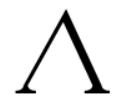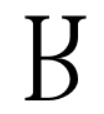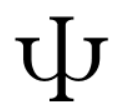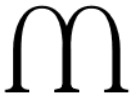Modern Gothic: Difference between revisions
mNo edit summary |
No edit summary |
||
| Line 1: | Line 1: | ||
{{construction}} | |||
[[Category:Languages]] | [[Category:Languages]] | ||
[[Category:Conlangs]] | [[Category:Conlangs]] | ||
| Line 32: | Line 34: | ||
Throughout this article I will be using a combination of Greek, Cyrillic, and Latin (both regular as well as some of the Insular forms that have Unicode representations) in order to write MG in a way that resembles its native script. | Throughout this article I will be using a combination of Greek, Cyrillic, and Latin (both regular as well as some of the Insular forms that have Unicode representations) in order to write MG in a way that resembles its native script. | ||
== | == Introduction == | ||
Modern Gothic is used in an alternate timeline where the Ostrogoths survived as a culture to the modern day. | Modern Gothic is used in an alternate timeline where the Ostrogoths survived as a culture to the modern day.The point of divergence is that around the 1st century AD, magic became real. Roughly speaking, from then until the 10th c. is the same. The 10th to 16th c. are marked by differences caused by the survival or death of various powers. While the 16th c. onward has become radically different. | ||
By the end of the 5th c. A.D., the Ostrogoths had made a kingdom in northern Italy. Unlike in our timeline, the Goths retained some strength, enough so that when the Byzantine empire tried to retake the West they were repelled, at first. In the 9th c. the Byzantines were able to conquer the Goths. From then until the 15th c. they were a subject of the Byzantines. | |||
In the early 14th c., the Byzantine-Seljuk wars started. The two empires had a series of wars, until the 16th c. when the Eastern Roman Empire fell. The Seljuk empire followed suit in the 19th c. When the East fell, the Seljuks attempted to claim their territories, but were only able to exert control into the Balkans. | |||
When the Ostrogoths gained independence, they did so alongside the Slovenians forming the Kingdom of Gothia-Slovenia. Relations between the groups decayed until 1933, when the nation fell into a civil war which ended in 1936 with the formal seperation of the kingdom into the Republic of Gothia and the Republic of Slovenia, the latter of which joined Yugoslavia in 1937. | |||
== Dialects == | == Dialects == | ||
Modern Gothic is divided into 2 branches: Coastal and Eastern. Coastal is comprised of both the Standard form of the language, as well as the Colloquial form which is closer to how the language is spoken in the modern day. Eastern Gothic is the term for a group of dialects that have diverged heavily from the coastal varieties.<br> | Modern Gothic is divided into 2 branches: Coastal and Eastern. Coastal is comprised of both the Standard form of the language, as well as the Colloquial form which is closer to how the language is spoken in the modern day. Eastern Gothic is the term for a group of dialects that have diverged heavily from the coastal varieties.<br> | ||
Revision as of 08:11, 28 July 2023
This article is a construction site. This project is currently undergoing significant construction and/or revamp. By all means, take a look around, thank you. |
| Modern Gothic | |
|---|---|
| Γnσɑvþɑʒɔ, Gusanrazd Γnσɜvþɑþɔ, Gusenrard | |
| Pronunciation | [/ˈgu.sən.ˌrast/ /ˈgu.sən.ˌrɐrt/] |
| Created by | sjacik |
| Setting | Unnamed Alternate Timeline |
| Native to | Gothia |
Indo-European
| |
Early form | |
| Official status | |
Official language in | Gothia |
Modern Gothic is an East Germanic language descended from a language similar to Biblical Gothic. Words will be given in Standard Modern Gothic and Colloquial Modern Gothic, if they differ.
Throughout this article I will be using a combination of Greek, Cyrillic, and Latin (both regular as well as some of the Insular forms that have Unicode representations) in order to write MG in a way that resembles its native script.
Introduction
Modern Gothic is used in an alternate timeline where the Ostrogoths survived as a culture to the modern day.The point of divergence is that around the 1st century AD, magic became real. Roughly speaking, from then until the 10th c. is the same. The 10th to 16th c. are marked by differences caused by the survival or death of various powers. While the 16th c. onward has become radically different.
By the end of the 5th c. A.D., the Ostrogoths had made a kingdom in northern Italy. Unlike in our timeline, the Goths retained some strength, enough so that when the Byzantine empire tried to retake the West they were repelled, at first. In the 9th c. the Byzantines were able to conquer the Goths. From then until the 15th c. they were a subject of the Byzantines.
In the early 14th c., the Byzantine-Seljuk wars started. The two empires had a series of wars, until the 16th c. when the Eastern Roman Empire fell. The Seljuk empire followed suit in the 19th c. When the East fell, the Seljuks attempted to claim their territories, but were only able to exert control into the Balkans.
When the Ostrogoths gained independence, they did so alongside the Slovenians forming the Kingdom of Gothia-Slovenia. Relations between the groups decayed until 1933, when the nation fell into a civil war which ended in 1936 with the formal seperation of the kingdom into the Republic of Gothia and the Republic of Slovenia, the latter of which joined Yugoslavia in 1937.
Dialects
Modern Gothic is divided into 2 branches: Coastal and Eastern. Coastal is comprised of both the Standard form of the language, as well as the Colloquial form which is closer to how the language is spoken in the modern day. Eastern Gothic is the term for a group of dialects that have diverged heavily from the coastal varieties.
From the late 19th century until 1977, there existed an artificially archaic form of the language that was used as the literary standard.
Orthography
Modern Gothic is written in a version of Wulfilas' Gothic alphabet, albeit with Greek influences. These include the use of sigma form of σɑnɥл saujl, as well as the adoption of bicameralism with the Greek minuscules being used for the majuscules that resembled the Greek uppercase. There are also Romance influences, such as the way spirantized consonants are written with a following r h (called ɑqл awl). However in the modern day it has become a diacritic above the letter that resembles an inverted breve, e.g. μıʒ̑vɑ̑ꞇ mizhnaht.
| Gothic | Name | IPA | Latin | ||||
|---|---|---|---|---|---|---|---|
| Uppercase | Lowercase | Uppercase | Lowercase | ||||
| Ʌ | ɑ | ɑσp ask | a | A | a | ||
| B | η | ηεþp berk | b | B | b | ||
| Γ | c | cb gy | g | G | g | ||
| Δ | ɔ | ɔɑp̑ dach | d | D | d | ||
| Є | ε | bε ioe | ε | E | e | ||
| Ɵ | ɵ | ɵþϕɑσσ eurthass | ɪ | Eu | eu | ||
| Ɛ | e | eþϕ eorth | œ | Eo | eo | ||
| Э | ɜ | σ̇ƚɑɑ shfaa | ə | A | a | ||
| Z | ʒ | b io | z | Z | z | ||
| Һ | r | ɑqл awl | h | H | h | ||
| Ψ | ϕ | ϕuϕ thiuth | θ | Th | th | ||
| I | ı | εıε eie | i | I | i | ||
| U | u | μup̑ miuch | ɨ | Iu | iu | ||
| Ю | b | cebл geiol | y | Io | io | ||
| P | p | pnσɑμ kusam | k | K | k | ||
| λ | л | лɑq law | l | L | l | ||
| M | μ | μɑvv mann | m | M | m | ||
| N | v | vɑnϕ nauth | n | N | n | ||
| G | ɥ | ɥεεþ jeer | j | J | j | ||
| Ƞ | n | onþε oure | u | U | u | ||
| Ɱ | m | ponı koui | ʊ | Ui | ui | ||
| Π | ϖ | ϖεþϕ perth | p | P | p | ||
| Ꙡ | þ | þɑıɔ̑ raidh | r | R | r | ||
| Σ | σ | σɑnɥл saujl | s | S | s | ||
| T | ꞇ | ꞇεın teiu | t | T | t | ||
| Ч | q | qıvɥ winj | w | W | w | ||
| Y | ɣ | ɣε ve | v | V | v | ||
| F | ƚ | ƚɑɑ faa | f | F | f | ||
| O | o | ooϕɑл oothal | ɔ | O | o | ||
Standard New Gothic
Phonology
Consonants
| Labial | Dental | Coronal | Dorsal | Glottal | |
|---|---|---|---|---|---|
| Nasal | m | n | (ŋ)1 | ||
| Stop | p2 b | t2 d | k2 g | ||
| Affricate | tʃ dʒ | ||||
| Fricative | f v3 | θ ð | t s ʃ ʒ | x | (h)4 |
| Approximant | j | ||||
| Trill | r |
1 /ŋ/ is found only before the velar stops
2 The voiceless stops are unaspirated
3 /v/ is realized as [w] intervocally
4 /h/ is only found between vowels, and is used to break up vowel sequences
Vowels
| Front | Central | Back | ||
|---|---|---|---|---|
| Unrounded | Rounded | |||
| Close | i iː iə̯ | y yː yə̯ | ɨ ɨː | u uː uə̯ |
| Close-mid | ɪ eː eə̯ | øː øə̯ | ʊ oː oə̯ | |
| Open-mid | ɛ ɛː ɛə̯ | œ œː œə̯ | ə | ɔ ɔː ɔə̯ |
| Open | a aː aə̯ | ɑ ɑː ɑə̯ | ||
/ɑə̯/ is incredibly rare, as the environment it comes from was mostly found only in compounds.
The centering diphthongs come from overlong vowels in Middle Gothic. No surviving dialect has kept them as overlong. They were either broken or shortened.
Sound changes from Biblical Gothic to Middle Gothic
General
/kʷ/ was re-analyzed as /kw/.
- Gothic 𐌵𐌹𐌼𐌰𐌽 qiman → *kwiman → pbμɑʒ kiomaz / pıμɜσ kimes / pbμσ kyms, 'to come'.
/mn/ assimilated to /mː/.
- Gothic 𐌷𐌹𐌼𐌹𐌽𐍃 himins → *himms → εμμ emm, 'heaven'.
Elision
Unstressed, short vowels are elided when near stressed and/or long occurrences of the same vowel.
- Gothic 𐌰𐌻𐌰𐌼𐌰𐌽𐌽𐍃 alamanns → *almanns → ɑлμɑvv almann, 'German'.
Metathesis
This primarily happened with liquids. if /l r/ are adjacent to /h/, they are switched so /h/ is either directly before or after a vowel.
- Gothic 𐌼𐌰𐍂𐌷𐍃 marhs → *mahrs → μɑ̑þ mȃr, 'horse'.
- Gothic 𐌷𐌻𐌷𐌾𐌰𐌽 hlahjan → *lhahjn → лɑ̑ɑ̑ɥʒ / лɑ̑ɑ̑ɥσ lȃȃjz / lȃȃjs, 'to laugh'.
H-Lowering
V + h clusters, or h + V, caused the vowel to be lowered. If the /h/ was after the vowel, said vowel gets lengthened.
- Gothic 𐌷𐌰𐍂𐌳𐌿𐍃 hardus → ɑ̑þɔ ȃrd, 'hard'.
- Gothic 𐍃𐌰𐌹𐌷𐍃 saihs → *saas → σɑɑ saa, 'six'.
W-Rounding
V + w clusters, or w + V, caused the vowel to be rounded. If the /w/ or /u̯/ was after the vowel, said vowel gets lengthened. Back vowels, /u ɔ uː oː ɔː/, became longer regardless if /w/ followed or preceded.
- Gothic 𐍅𐌹𐌽𐍄𐍂𐌿𐍃 wintrus → *iontrus → bꞇꞇþɑ iottra / ıꞇꞇɜþ itter / bꞇꞇþ NMG yttr, 'winter'.
- Gothic 𐍆𐌹𐌳𐍅𐍉𐍂 fidwor → ƚıɔoɑþ / ƚıɔoþ fidoar / fidor , 'four'.
- Gothic 𐌸𐌹𐌿𐌳𐌰 thiuda → ψuɔ̑ / ψuψ thiudh / thiuth, 'people'.

























































